| |
A todos los amigos españoles, especialmente a los madrileños. Madrid donde vivé hace unos años.
Que los pitos nos recuerden que la vida siempre triumfará de la muerte.
Discovery context:
We will study 12 whistles this month. Those whistles were bought in an estate within 25 whistles made in different countries.
General description:
All the whistles are modeled in a beige clay in anthropomorphic or zoomorphic shapes except for one whistle representing an aircraft.
The decoration:
The whistles are white washed then some green, red, yellow or blue lines are quickly painted.
| 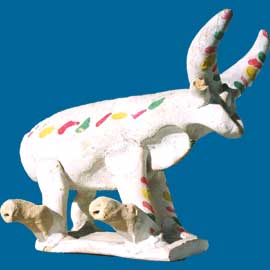
  |
|
| |
Study of the object
Typology: All these whistles are tubular whistles. When the statuette has a base, the whistle is often put on this one (Nixdorff's category B5) but for some statuettes (men, animals), the whistle is inserted directly into it (Nixdorff's category B3).
For the plane; the tail of the plane is the whistle
Analyze:
These whistles belong to a famous category: the "siurells" from the Balearic Islands. These characteristic whistles are now a symbol of these islands. The most famous amateur of these "siurells" was the painter Joan Miró. Still manufactured for the tourists, the whistles studied here seem to be antique ones.
The siurells are often described as some survivals from the age of Bronze. |
|
| |
The "siurells":
There are several possible orthographies: "siurell", "siulet" or "xiurell" and "xiulet". The most usual one today is "siurell".
These whistles were sold formerly during patronal fairs. The most famous one was located in the village of Sineu .
They were also sold during the San Bernardo fairs, New Year's day or the Nativity of the Virgin's day around the town of Palma or during the San Marcial fair in Marratxí.
In 1952, the production of the siurells was located in Pórtol, Inca, sa Cabaneta, Llubí, Felanitx, Sineu and Artá. Before 1950 they would have been made also in Manacor, Santa Maria and Palma.
This production was thus very common. The whistles were produced in small family pottery workshops.
In 1978, the pottery centers of Pórtol, Inca and Santa Maria in the island of Palma still existed in the Balearic Islands. The old pottery centers of Consell and sa Cabaneta manufactured nothing any more but the siurells.
This production was especially the production of the women while the men devoted themselves to the production of bigger items.
The decoration:
Except for the siurells of the years 1950-60 covered with various glazes (green, Prussian blue, black, maroon, pale yellow, orange or blood red), the traditional whistles are covered with white lime then painted with colored lines.
Neither the colors nor the shapes make it possible to differentiate the places of production. |
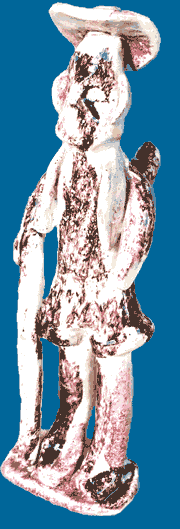 Earthenware Siurell.
Glaze mottled with manganese
Artist's production marked "50/100" |
|
| |
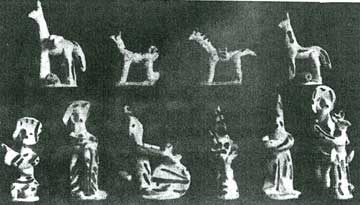 Ampurias "Cerámica popular: los "siurells baleáricos
1940s-50s |
1950: the break.
An article of 1952 in the magazine Ampurias: "Cerámica popular: los siurells baleáricos" by Carlos Cid Priego makes it possible to date the series of the studied whistles in the first half of the 20th century. All the whistles photographed in the article are very close to the whistles of the batch.
In this article, the author writes that at this time, these whistles were largely forgotten and neglected by the children of the Balearic Islands.
They were the foreigners or the cultured people who started to be interested in these objects. Due to this new interest, their sale first limited to the local festivals, developed then permanently in the tourist shops .
The siurells entered in the museums and a production of earthenware siurells appeared.
Today, the fashion returned to the white washed clay models but their shapes are heavier. The "siurells" are often stereotyped. |
|
| |
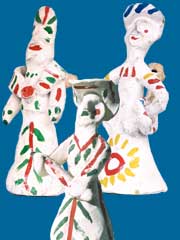 from left to right
Woman with a tiara
Woman with a "loaf?"
woman with a "round loaf" |
Typology:
Unfortunately, no text former to the 19th century give information about the old whistles. A collection with very rare and old siurells was quoted in the Balearic Islands but this collection disappeared at the beginning of the 20th century. It is thus difficult to establish a chronology of the models.
The humans:
- Women with wide hats or tiaras and large dresses
- women with "offerings" (bread?)
- standing or sitting men
- motorcyclists and footballers
- men "at prayer?"
- saints in particular the Blessed Virgin (who never has whistle on the figurine)
These statuettes, in spite of their archaic look, often represent the peasants in the market or the people of the islands.
| 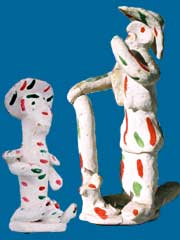 Sitting man
Standing man with a stick and a dog |
|
| |
The animals:
- the bulls with long horns
- the bulls and other animals with wings of a butterfly
- the dogs: generally seated, rarely standing up and alone and sometimes with a hen between its legs
- the asses with a long neck and the horses
- the birds: very rare when alone but frequently part of groups
Miscellaneous:
The groups:
- the ploughman and his ass
- the rider
- the dog trying to catch a bird...
the chronology:
The article of Mr. Priego proposed the following chronology:
the antique types
- the dancers with zoomorphic heads
- the men at prayer
- the women with wide dress
- the winged bulls or animals
the types of the 18th and 19th centuries
- the penitent ones
- the animals (hens and dogs)
the types of the 20th century
- the motorcyclists
- the planes
| 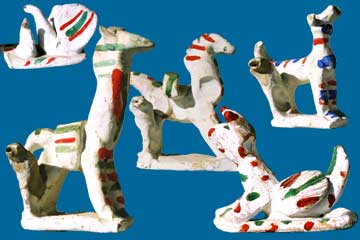 From L to R
Birds
Ass
Horse
Dog
Winged animal |
|
| |
Origins:
It would be easy to speculate in the resemblances between the siurells and the protohistoric figurines of Crete. But no old siurell makes it possible to know how old these shapes are or to confirm a chronology.
To look for the origin of the siurells in the Andalusian medieval whistles has no sense. Their shapes and typology are fundamentally different.
The siurells are also very different of the small jugs made in Agost in the Spanish coast.
The principle of the whistle inserted into the statuette or on the base is similar to the Italian models, the old whistles of Provence or the Portuguese whistles as for the prevalence of the local people in the models (country, notable...).
But some models of siurells are unknown elsewhere in the Mediterranean world.
Who could explain the animals with the wings of butterfly, the statuettes of the dancing men or the figurines with a zoomorphic head?
The "siurell" will keep its mystery probably for a long time. |
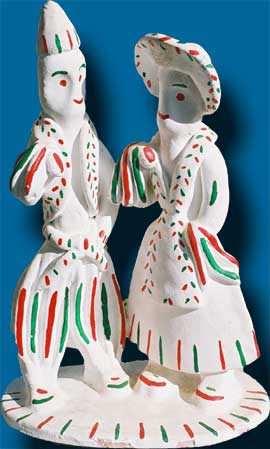 Couples of peasants.
circa 1990 |
|